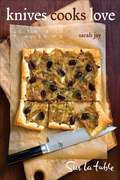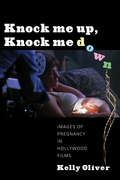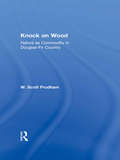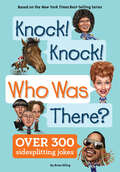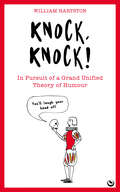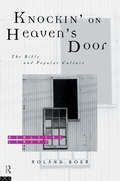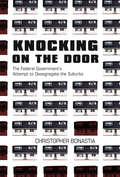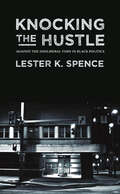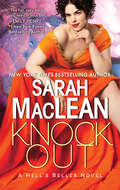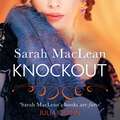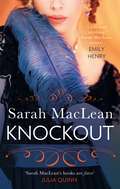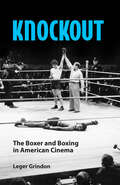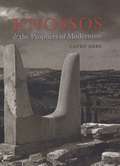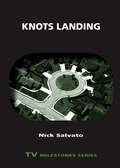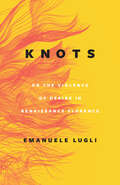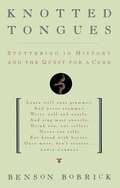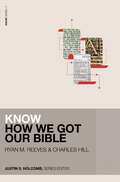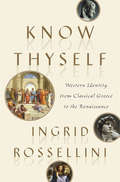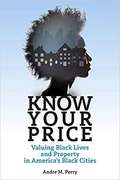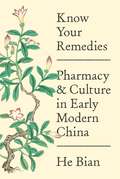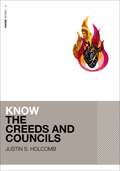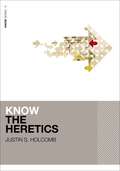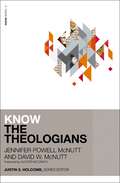- Table View
- List View
Knives Cooks Love: Selection, Care, Techniques, Recipes
by Ben Fink Sarah Jay Sur La Table StaffIn 'Knives Cooks Love', trusted cookware authority Sur La Table teams up with writer Sarah Jay to guide chefs of all levels so their knives will last a lifetime. The nuances between knife blades and handles are discussed, as well as cutting surfaces and an array of sharpeners and honers. Numerous cutting techniques are also showcased with step-by-step instructions and photographs. These skills are then put to the test with more than 20 knife-essential, tantalising recipes like Mango-Cucumber Salsa, Mediterranean-Style Mussels with Fennel and Tomatoes, Arroz con Pollo with Chorizo and Capers, and Bread and Butter Pudding with Rum and Crystallised Ginger.
Knock Me Up, Knock Me Down: Images of Pregnancy in Hollywood Films
by Kelly OliverNo longer is pregnancy a repulsive or shameful condition in Hollywood films, but an attractive attribute, often enhancing the romantic or comedic storyline of a female character. Kelly Oliver investigates this curious shift and its reflection of changing attitudes toward women's roles in reproduction and the family. Not all representations signify progress. Oliver finds that in many pregnancy films, our anxieties over modern reproductive practices and technologies are made manifest, and in some cases perpetuate conventions curtailing women's freedom. Reading such films as Where the Heart Is (2000), Riding in Cars with Boys (2001), Palindromes (2004), Saved! (2004), Quinceañera (2006), Children of Men (2006), Knocked Up (2007), Juno (2007), Baby Mama (2008), Away We Go (2009), Precious (2009), The Back-up Plan (2010), Due Date (2010), and Twilight: Breaking Dawn (2011), Oliver investigates pregnancy as a vehicle for romance, a political issue of "choice," a representation of the hosting of "others," a prism for fears of miscegenation, and a screen for modern technological anxieties.
Knock on Wood: Nature as Commodity in Douglas-Fir Country
by W. Scott PrudhamScott Prudham investigates a region that has in recent years seen more environmental conflict than perhaps anywhere else in the country--the old-growth forests of the Pacific Northwest. Prudham employs a political economic approach to explain the social and economic conflicts arising from the timber industry's presence in the region. As well, he provides a thorough accounting of the timber industry itself, tracing its motivations, practices, and labor relations.
Knock! Knock! Who Was There? (Who Was?)
by Brian Elling Who HQOver 300 side-splitting jokes based on the New York Times best-selling series.If you want to know exactly why Milton Hershey's wife married him, look no further. (Because she wanted lots of Hershey's Kisses!) This hilarious and original collection of jokes featuring all the subjects of the ever-popular Who Was? series will keep kids laughing right through history class! Q: Why did Betsy Ross wear long dresses?A: To cover her colo-knees!Q: Which playwright is also a great cook?A: Will-yum Shakespeare!Q: Which president liked lasers?A: Ronald Ray-gun!
Knock, Knock: In Pursuit of a Grand Unified Theory of Humour
by William HartstonThe first mainstream history of humour. Hilarious and well-researched, this book from household name William Hartston, a presenter, author and journalist, makes a perfect gift.Of all human qualities, humour is perhaps the most puzzling. In this very first history of humour, author and humourist William Hartston looks at every aspect of the evolution of humour and our attitudes towards it with a view to developing a proper Theory Of Everything Humorous.From comedy in ancient Greece and jokes in ancient Rome, to laughter in the Bible and the secret of comic delivery; from how humour changed following the American civil war, to how Mark Twain changed written comedy in the English-speaking world, William leaves no stone unturned in his quest to understand what makes us chuckle. Besides being academically well-founded, A History of Humour will, unlike almost everything else written on the subject, be both seriously humorous and humorously serious.
Knockin' on Heaven's Door: The Bible and Popular Culture (Biblical Limits)
by Roland BoerKnockin' On Heaven's Door offers a critically sophisticated and truly interdisciplinary analysis of the relationship between biblical studies and contemporary culture.Specific biblical texts are examined in the light of cultural criticism and areas of popular culture including pornography, heavy metal music and McDonald's hamburgers in the light of biblical criticism.
Knocking on the Door: The Federal Government's Attempt to Desegregate the Suburbs
by Christopher BonastiaKnocking on the Door is the first book-length work to analyze federal involvement in residential segregation from Reconstruction to the present. Providing a particularly detailed analysis of the period 1968 to 1973, the book examines how the U.S. Department of Housing and Urban Development (HUD) attempted to forge elementary changes in segregated residential patterns by opening up the suburbs to groups historically excluded for racial or economic reasons. The door did not shut completely on this possibility until President Richard Nixon took the drastic step of freezing all federal housing funds in January 1973. Knocking on the Door assesses this near-miss in political history, exploring how HUD came surprisingly close to implementing rigorous antidiscrimination policies, and why the agency's efforts were derailed by Nixon. Christopher Bonastia shows how the Nixon years were ripe for federal action to foster residential desegregation. The period was marked by new legislative protections against housing discrimination, unprecedented federal involvement in housing construction, and frequent judicial backing for the actions of civil rights agencies. By comparing housing desegregation policies to civil rights enforcement in employment and education, Bonastia offers an unrivaled account of why civil rights policies diverge so sharply in their ambition and effectiveness.
Knocking the Hustle: Against the Neoliberal Turn in Black Politics
by Lester K. SpenceLester K. Spence writes the effects of this transformation on African American communities, in an attempt to revitalize the black political imagination. <P><P>Rather than asking black men and women to "hustle harder", Spence criticizes the act of hustling itself as a tactic used to demobilize and dis empower the communities most in need of empowerment.
Knockout: A Hell's Belles Novel (Hell's Belles #3)
by Sarah MacLeanNew York Times bestselling author Sarah MacLean returns with the next Hell’s Belles novel about a chaotic bluestocking and the buttoned-up detective enlisted to keep her out of trouble (spoiler: She is the trouble). With her headful of wild curls and wilder ideas and an unabashed love of experiments and explosives, society has labeled Lady Imogen Loveless peculiar…and doesn’t know she’s one of the Hell’s Belles—a group of vigilantes operating outside the notice of most of London.Thomas Peck is not most of London. The brilliant detective fought his way off the streets and into a promising career through sheer force of will and a keen ability to see things others miss, like the fact that Imogen isn’t peculiar…she’s pandemonium. If you ask him, she requires a keeper. When her powerful family discovers her late-night activities, they couldn’t agree more…and they know just the man for the task.Thomas wants nothing to do with guarding Imogen. He is a grown man with a proper job and no time for the lady’s incendiary chaos, no matter how lushly it is packaged. But some assignments are too explosive to pass up, and the gruff detective is soon caught up in Imogen’s world, full of her bold smiles and burning secrets…and a fiery passion that threatens to consume them both.
Knockout: A passionate opposites-attract Regency romance
by Sarah MacLeanNew York Times bestselling author Sarah MacLean returns with the next Hell's Belles novel about a chaotic bluestocking and the buttoned-up detective enlisted to keep her out of trouble (spoiler: She is the trouble). 'Sarah MacLean's books are fierce' JULIA QUINN'I will read anything Sarah MacLean writes' EMILY HENRY'Sharp, sexy, action-packed, propulsive escapism at its absolute finest. We are lucky to be living and breathing in the Sarah Maclean era' CHRISTINA LAUREN................With her headful of wild curls and wilder ideas, society has labelled Lady Imogen Loveless peculiar . . . and doesn't know she's one of the Hell's Belles - a group of vigilantes operating outside the notice of most of London.Thomas Peck is not most of London. The brilliant detective has a keen ability to see things others miss, like the fact that Imogen isn't peculiar...she's pandemonium. If you ask him, she requires a keeper. When her powerful family discovers her late-night activities, they couldn't agree more . . . and they know just the man for the task.Thomas wants nothing to do with guarding Imogen. He is a grown man with a proper job and no time for the lady's incendiary chaos, no matter how lushly it is packaged. Yet as the gruff detective becomes caught up in Imogen's world, they each discover an unexpected but fiery passion that threatens to consume them both.................Praise for Sarah MacLean:'Fun with a capital F, a spectacular, near-cinematic adventure . . . Heartbreaker is a full-hearted, deeply romantic reminder that romance novels can and should be dangerous and fun in equal measure' Entertainment Weekly'Sublimely sensual and passionate' Kirkus Reviews'Everything MacLean does is perfectly on point' Booklist'Romance readers can always rely on Sarah MacLean to bring the summer heat' Bookish
Knockout: A passionate opposites-attract Regency romance
by Sarah MacLeanNew York Times bestselling author Sarah MacLean returns with the next Hell's Belles novel about a chaotic bluestocking and the buttoned-up detective enlisted to keep her out of trouble (spoiler: She is the trouble). 'Sarah MacLean's books are fierce' JULIA QUINN'I will read anything Sarah MacLean writes' EMILY HENRY'Sharp, sexy, action-packed, propulsive escapism at its absolute finest. We are lucky to be living and breathing in the Sarah Maclean era' CHRISTINA LAUREN................With her headful of wild curls and wilder ideas, society has labelled Lady Imogen Loveless peculiar . . . and doesn't know she's one of the Hell's Belles - a group of vigilantes operating outside the notice of most of London.Thomas Peck is not most of London. The brilliant detective has a keen ability to see things others miss, like the fact that Imogen isn't peculiar...she's pandemonium. If you ask him, she requires a keeper. When her powerful family discovers her late-night activities, they couldn't agree more . . . and they know just the man for the task.Thomas wants nothing to do with guarding Imogen. He is a grown man with a proper job and no time for the lady's incendiary chaos, no matter how lushly it is packaged. Yet as the gruff detective becomes caught up in Imogen's world, they each discover an unexpected but fiery passion that threatens to consume them both.................Praise for Sarah MacLean:'Fun with a capital F, a spectacular, near-cinematic adventure . . . Heartbreaker is a full-hearted, deeply romantic reminder that romance novels can and should be dangerous and fun in equal measure' Entertainment Weekly'Sublimely sensual and passionate' Kirkus Reviews'Everything MacLean does is perfectly on point' Booklist'Romance readers can always rely on Sarah MacLean to bring the summer heat' Bookish
Knockout: The Boxer and Boxing in American Cinema
by Leger GrindonKnockout: The Boxer and Boxing in American Cinema is the first book-length study of the Hollywood boxing film, a popular movie entertainment since the 1930s, that includes such classics as Million Dollar Baby, Rocky, and Raging Bull. The boxer stands alongside the cowboy, the gangster, and the detective as a character that shaped America’s ideas of manhood. Leger Grindon relates the Hollywood boxing film to the literature of Jack London, Ernest Hemingway, and Clifford Odets; the influence of ring champions, particularly Joe Louis and Muhammad Ali; and controversies surrounding masculinity, race, and sports. Knockout breaks new ground in film genre study by focusing on the fundamental dramatic conflicts uniting both documentary and fictional films with compelling social concerns. The boxing film portrays more than the rise and fall of a champion; it exposes the body to reveal the spirit. Not simply a brute, the screen boxer dramatizes conflicts and aspirations central to an American audience’s experience. This book features chapters on the conventions of the boxing film, the history of the genre and its relationship to famous ring champions, and self-contained treatments of thirty-two individual films including a chapter devoted to Raging Bull.
Knossos and the Prophets of Modernism
by Cathy GereIn the spring of 1900, British archaeologist Arthur Evans began to excavate the palace of Knossos on Crete, bringing ancient Greek legends to life just as a new century dawned amid far-reaching questions about human history, art, and culture. Over the next three decades, Evans engaged in an unprecedented reconstruction project, creating a complex of concrete buildings on the site that owed at least as much to modernist architecture as they did to Bronze Age remains. In the process, he fired the imaginations of a whole generation of intellectuals and artists, whose work would drive movements as disparate as fascism and pacifism, feminism and psychoanalysis. With Knossos and the Prophets of Modernism, Cathy Gere relates the fascinating story of Evans's excavation and its long-term effects on Western culture. Gere shows how Evans's often-fanciful account of ancient Minoan society captivated a generation riven by serious doubts about the fundamental values of European civilization. After the First World War left the Enlightenment dream in tatters, the lost paradise that Evans offered in the concrete labyrinth--pacifist and matriarchal, pagan and cosmic--seemed to offer a new way forward for writers, artists, and thinkers such as Freud, James Joyce, Georgio de Chirico, Robert Graves, Hilda Doolittle, all of whom emerge as forceful characters in Gere's account. Assembling a brilliant, talented, and eccentric cast at a moment of tremendous intellectual vitality and wrenching change, Cathy Gere paints an unforgettable portrait of the age of concrete and the birth of modernism.
Knots Landing (TV Milestones Series)
by Nick SalvatoAiring on CBS for fourteen seasons (1979-93), Knots Landing was a spinoff of the popular drama Dallas, but ultimately ran longer and took a very different tone on domestic, social, and economic issues than its predecssor. In the first full-length scholarly study of Knots Landing, Nick Salvato situates the series in its economic and industrial contexts, addresses its surprisingly progressive relationship to the American politics of its period, offers close formal interpretations of noteworthy episodes, and unpacks the pleasures of the program's sensuous surfaces. While it has been largely overlooked in studies of 1980s television, Knots Landing nonetheless beat more masculine fare like Hill Street Blues and L.A. Law in the ratings, introduced a novel focus on middle-class lives in melodrama, and launched or revived the careers of its major stars. In this study Salvato investigates the series' place in widespread serialization of American primetime television in the early 1980s and the end of network dominance in the early 1990s, along with its unique relationship to Reaganism and glamour, on the one hand, and everydayness and suburbanization, on the other. Salvato also looks at the series in relation to key concepts such as memory, theatricality, identification, "quality" TV, and stardom. Fans of the series as well as readers interested in popular culture, television history, representations of gender, and constructions of celebrity will find much to enjoy in this volume.
Knots, or the Violence of Desire in Renaissance Florence
by Emanuele LugliAn interdisciplinary study of hair through the art, philosophy, and science of fifteenth-century Florence. In this innovative cultural history, hair is the portal through which Emanuele Lugli accesses the cultural production of Lorenzo il Magnifico’s Florence. Lugli reflects on the ways writers, doctors, and artists expressed religious prejudices, health beliefs, and gender and class subjugation through alluring works of art, in medical and political writings, and in poetry. He considers what may have compelled Sandro Botticelli, the young Leonardo da Vinci, and dozens of their contemporaries to obsess over braids, knots, and hairdos by examining their engagement with scientific, philosophical, and theological practices. By studying hundreds of fifteenth-century documents that engage with hair, Lugli foregrounds hair’s association to death and gathers insights about human life at a time when Renaissance thinkers redefined what it meant to be human and to be alive. Lugli uncovers overlooked perceptions of hair when it came to be identified as a potential vector for liberating culture, and he corrects a centuries-old prejudice that sees hair as a trivial subject, relegated to passing fashion or the decorative. He shows hair, instead, to be at the heart of Florentine culture, whose inherent violence Lugli reveals by prompting questions about the entanglement of politics and desire.
Knots, or the Violence of Desire in Renaissance Florence
by Emanuele LugliAn interdisciplinary study of hair through the art, philosophy, and science of fifteenth-century Florence. In this innovative cultural history, hair is the portal through which Emanuele Lugli accesses the cultural production of Lorenzo il Magnifico’s Florence. Lugli reflects on the ways writers, doctors, and artists expressed religious prejudices, health beliefs, and gender and class subjugation through alluring works of art, in medical and political writings, and in poetry. He considers what may have compelled Sandro Botticelli, the young Leonardo da Vinci, and dozens of their contemporaries to obsess over braids, knots, and hairdos by examining their engagement with scientific, philosophical, and theological practices. By studying hundreds of fifteenth-century documents that engage with hair, Lugli foregrounds hair’s association to death and gathers insights about human life at a time when Renaissance thinkers redefined what it meant to be human and to be alive. Lugli uncovers overlooked perceptions of hair when it came to be identified as a potential vector for liberating culture, and he corrects a centuries-old prejudice that sees hair as a trivial subject, relegated to passing fashion or the decorative. He shows hair, instead, to be at the heart of Florentine culture, whose inherent violence Lugli reveals by prompting questions about the entanglement of politics and desire.
Knotted Tongues: Stuttering in History and the Quest for a Cure
by Benson BobrickTwo and a half million Americans - fifty-five million people worldwide - stutter. Though their baffling malady has been subjected to endless analysis for over 2,500 years, most endure it without hope of a cure. The very anticipation of stuttering can dominate a victim's social and emotional life. If the majority suffer in anonymity, famous figures down through the ages - Moses, Charles I, Lewis Carroll, Henry James, W. Somerset Maugham, Winston Churchill, and Marilyn Monroe among them - have also known the isolation and trauma of living with knotted tongues. Indeed, Charles Dickens once aptly described stuttering as "a barrier by which the sufferer feels that the world without is separated from the world within.". In this fascinating and original social history, which combines literary scholarship with historical research, Benson Bobrick explores one of the great conundrums of medical history, its impact on the lives of the afflicted, and the astonishing therapeutic practices it has spawned. Demosthenes was obliged to labor up steep inclines with lead plates strapped to his chest and to declaim over the roar of the ocean with pebbles in his mouth; one 16th-century Italian physician prescribed nosedrops combining beetroot and coriander to help "dehumidify" the brain; and a Native American tribe had stutterers spit through a hole in a board "to get the devil out of their throats.". At one time or another, stuttering has been popularly traced to childhood trauma; sibling rivalry; suppressed anger; infantile sexual fixations; deformations of the tongue, lips, or jaw; chemical imbalance; strict upbringing; vicious habit; guilt; approach-avoidance conflicts; and so on, and has been treated by hypnosis, drugs, conditioning, electric shock, and of course, psychoanalysis. Mounting clinical evidence today, however, indicates that stuttering is a neurological problem, possibly involving anomalies of sound transmission through the skull. Genetic research suggests a familial link. While a definitive cure remains elusive, certain therapeutic techniques are effective, as the author explains in a compelling account of his own successful quest for deliverance
Know How We Got Our Bible (KNOW Series)
by Charles E. Hill Ryan Matthew ReevesThe easy accessibility of the Bible in most of the world's major languages can obscure a dramatic and sometimes unexpected story. In Know How We Got Our Bible, scholars Ryan Reeves and Charles Hill trace the history of the Bible from its beginnings to the present day, highlighting key figures and demonstrating overall the reliability of Scripture.Reeves and Hill begin with the writing of the Bible's books (including authorship and dating), move into the formation of the Old and New Testaments (including early transmission and the development of the canon), and conclude with several chapters on Bible translation from the Latin Vulgate to the ongoing work of translation around the world today.Written simply and focused on the overarching story of how the Bible came to us today, Know How We Got Our Bible is an excellent introduction for formal students and lay learners alike. Each chapter includes reflection questions and recommended readings for further learning.
Know Thyself: Western Identity from Classical Greece to the Renaissance
by Ingrid RosselliniA lively and timely introduction to the roots of self-understanding--who we are and how we should act--in the cultures of ancient Greece, the Roman Empire, and Middle Ages and the Renaissance "Know thyself"--this fundamental imperative appeared for the first time in ancient Greece, specifically in Delphi, the temple of the god Apollo, who represented the enlightened power of reason. For the Greeks, self-knowledge and identity were the basics of their civilization and their sources were to be found in where one was born and into which social group. These determined who you were and what your duties were. In this book the independent scholar Ingrid Rossellini surveys the major ideas that, from Greek and Roman antiquity through the Christian medieval era up to the dawn of modernity in the Renaissance, have guided the Western project of self-knowledge. Addressing the curious lay reader with an interdisciplinary approach that includes numerous references to the visual arts, Know Thyself will reintroduce readers to the most profound and enduring ways our civilization has framed the issues of self and society, in the process helping us rediscover the very building blocks of our personality.
Know Your Price: Valuing Black Lives and Property in America's Black Cities
by Andre M. PerryThe deliberate devaluation of Blacks and their communities has had very real, far-reaching, and negative economic and social effects. An enduring white supremacist myth claims brutal conditions in Black communities are mainly the result of Black people’s collective choices and moral failings. “That’s just how they are” or “there’s really no excuse”: we’ve all heard those not so subtle digs. <P><P> But there is nothing wrong with Black people that ending racism can’t solve. We haven’t known how much the country will gain by properly valuing homes and businesses, family structures, voters, and school districts in Black neighborhoods. And we need to know. <P><P> Noted educator, journalist, and scholar Andre Perry takes readers on a tour of six Black-majority cities whose assets and strengths are undervalued. Perry begins in his hometown of Wilkinsburg, a small city east of Pittsburgh that, unlike its much larger neighbor, is struggling and failing to attract new jobs and industry. Bringing his own personal story of growing up in Black-majority Wilkinsburg, Perry also spotlights five others where he has deep connections: Detroit, Birmingham, New Orleans, Atlanta, and Washington, D.C. He provides an intimate look at the assets that should be of greater value to residents—and that can be if they demand it. <P><P> Perry provides a new means of determining the value of Black communities. Rejecting policies shaped by flawed perspectives of the past and present, it gives fresh insights on the historical effects of racism and provides a new value paradigm to limit them in the future. <P><P> Know Your Price demonstrates the worth of Black people’s intrinsic personal strengths, real property, and traditional institutions. These assets are a means of empowerment and, as Perry argues in this provocative and very personal book, are what we need to know and understand to build Black prosperity.
Know Your Remedies: Pharmacy and Culture in Early Modern China
by He BianA cultural history of the concept of pharmacy, both the material nature of drugs and the trade in medicine, in early modern China Know Your Remedies presents a panoramic inquiry into China’s early modern cultural transformation through the lens of pharmacy. In the history of science and civilization in China, pharmacy—as a commercial enterprise and as a branch of classical medicine—resists easy characterization. While China’s long tradition of documenting the natural world through state-commissioned pharmacopeias, known as bencao, dwindled after the sixteenth century, the ubiquitous presence of Chinese pharmacy shops around the world today testifies to the vitality of Traditional Chinese Medicine. Rejecting narratives of intellectual stagnation or an unchanging folk culture, He Bian argues that pharmacy’s history in early modern China can best be understood as a dynamic interplay between elite and popular culture.Beginning with decentralizing trends in book culture and fiscal policy in the sixteenth century, Bian reveals pharmacy’s central role in late Ming public discourse. Fueled by factional politics in the early 1600s, amateur investigation into pharmacology reached peak popularity among the literati on the eve of the Qing conquest in the mid-seventeenth century. The eighteenth century witnessed a systematic reclassification of knowledge, as the Qing court turned away from pharmacopeia in favor of a demedicalized natural history. Throughout this time, growth in long-distance trade enabled the rise of urban pharmacy shops, generating new knowledge about the natural world.Bringing together a wealth of primary sources, Know Your Remedies makes an essential contribution to the study of Chinese history and the history of medicine.
Know the Creeds and Councils (KNOW Series)
by Justin S. HolcombIn every generation, the Christian church must interpret and restate its bedrock beliefs, answering the challenges and concerns of the day. This accessible overview walks readers through centuries of creeds, councils, catechisms, and confessions—not with a dry focus on dates and places, but with an emphasis on the living tradition of Christian belief and why it matters for our lives today.As a part of the KNOW series, Know the Creeds and Councils is designed for personal study or classroom use, but also for small groups and Sunday schools wanting to more deeply understand the foundations of the faith.Each chapter covers a key statement of faith and includes a discussion of its historical context, a simple explanation of the statement’s content and key points, reflections on contemporary and ongoing relevance, and discussion questions.
Know the Heretics (KNOW Series)
by Justin S. HolcombThere is a lot of talk about heresy these days. The frequency and volume of accusations suggest that some Christians have lost a sense of the gravity of the word. On the other hand, many believers have little to no familiarity with orthodox doctrine or the historic distortions of it.What’s needed is a strong dose of humility and restraint, and also a clear and informed definition of orthodoxy and heresy. Know the Heretics provides an accessible “travel guide” to the most significant heresies throughout Christian history. As a part of the KNOW series, it is designed for personal study or classroom use, but also for small groups and Sunday schools wanting to more deeply understand the foundations of the faith.Each chapter covers a key statement of faith and includes a discussion of its historical context; a simple explanation of the unorthodox teaching, the orthodox response and a key defender; reflections of contemporary relevance; and discussion questions.
Know the Theologians (KNOW Series)
by Jennifer Powell McNutt David McNuttKnow the Theologians is an introduction to the most important thinkers throughout church history and a demonstration of their ongoing relevance for believers today.The Bible describes the church as a kind of family. Those who believe in Christ are sisters and brothers in the faith, whether they live at the same time or are separated by centuries. For that reason, believers today need to know our family members who have come before and shaped our beliefs and practices now. In Know the Theologians, professors and authors Jennifer Powell McNutt and David W. McNutt introduce the most significant thinkers in the church's history.McNutt and McNutt survey over a dozen primary figures, including Eastern Orthodox, Roman Catholic, and Protestant theologians, who represent the breadth and depth of the church's theology. The book explores how they fit into their own time period and also draws attention to the theological voices of women throughout the church's history. Every chapter includes short sidebars on figures contemporary to the main theologians, bringing in additional important voices.This book has everything you need for a full personal or group study experience.As part of the KNOW series, Know the Theologians is designed for either personal study or classroom use, and it will also be an accessible resource for small groups and adult education in churches. Chapters end with reflection questions and recommended reading for further study.An individual access code to stream all video sessions online. (You don&’t need to buy a DVD!)Sessions:PART 1: EARLY CHRISTIAN THEOLOGIANS1. Irenaeus of Lyons2. Athanasius of Alexandria3. The Cappadocian Four4. Augustine of HippoPART 2: MEDIEVAL THEOLOGIANS5. John of Damascus6. Anselm of Canterbury7. Julian of Norwich8. Thomas AquinasPART 3: REFORMATION THEOLOGIANS9. Martin Luther10. John Calvin11. Menno Simons12. Teresa of AvilaPART 4: MODERN THEOLOGIANS13. The Wesley Brothers14. Friedrich Schleiermacher15. Karl Barth16. Gustavo GutiérrezStreaming video access code included.?Access code subject to expiration after 4/2/2029. Code may be redeemed only by the recipient of this package. Code may not be transferred or sold separately from this package. Internet connection required. Void where prohibited, taxed, or restricted by law. Additional offer details inside.
Knowing Asia, Being Asian: Cosmopolitanism and Nationalism in Bengali Periodicals, 1860–1940
by Sarvani GooptuThis book studies the various representations of Asia in Bengali literary periodicals between the 1860s and 1940s. It looks at how these periodicals tried to analyse the political situation in Asia in the context of world politics and how Indian nationalistic ideas and associations impacted their vision. The volume highlights the influences of cosmopolitanism, universalism and nationalism which contributed towards a common vision of a united and powerful Asia and how these ideas were put into practice. It analyses travel accounts by men and women and examines how women became the focus of the didactic efforts of all writers for a horizontal dissemination of Asian consciousness. The author also provides a discussion on Asian art and culture, past and present connections between Asian countries and the resurgence of 19th-century Buddhism in the consciousness of the Bengalis. Rich in archival material, Knowing Asia, Being Asian will be useful for scholars and researchers of history, Asian studies, modern India, cultural studies, media studies, journalism, publishing, post-colonial studies, travel writings, women and gender studies, political studies and social anthropology.
